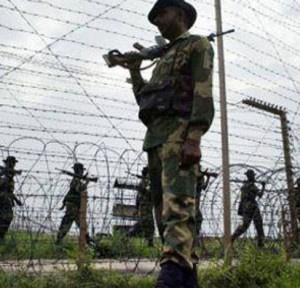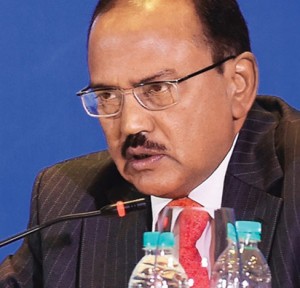Miscreant India: violations of the ceasefire proved
Going by the standards of proof on which the Indian media operates, proving anything only takes a phone call recording- even if its forensically unverified. At least this is how Arnab Goswami proved that Dawood Ibrahim is living in Karachi, and most daringly, while also engaging in chest-thumping, called out Dawood Ibrahim. Such a story could only be planted on the instructions of Ajit Kumar Doval, India’s national security advisor, who once upon a time tried to murder Dawood in Dubai with the help of two gang members of the Chota Rajan group, until Mumbai police arrested both of these criminals from Doval’s hotel room. Now promoted, and a part of Narendera Modi’s kitchen cabinet, the man cannot get over his Pakistan-phobia. He’s the man behind the imprudent idea to engage Pakistani forces on the eastern border. Why would he do that, the answer to this lies in another question, who is to benefit if the skirmishes over the Line of Control keep going on?
Clearly, Pakistan has no benefit if the tensions along its eastern border escalate. It is already engaged in an effort to eradicate militancy which is centered proximal towards its western border. This is in the interests of both Pakistan and Afghanistan and paves the way for improved relations between the two brotherly nations, and this fact cannot be digested by the Indian government and Mr. Doval. On the fifth of October, Pakistani security forces decided to continue Operation Zarb-e-Azab, despite the upcoming winter, with this decision they dispelled the impression that the harsh weather may force the security forces to halt the ongoing offensive against terrorists, which has been ongoing since mid-June 2014. “Conducting operation in winters is certainly a challenge for the security forces but it is also a challenge for militants,” a military official told the media. This hit the Indian government unexpectedly, which had sighed a relief under the impression that the operation against Indian sponsored terrorists may allow the Indian government some time in strategically helping their mercenaries regain lost ground.
On the 6th of October, the very next day the decision was made public. Indian Border Security Forces (BSF) personnel fired along the working boundary in Sialkot, killing four, to which the Pakistani rangers responded with full force. The exact next day, nine more civilians were killed when the Indian BSF fired and shelled at civilian establishment in villages near Charwa Sector, once again the Pakistani Rangers gave a befitting response to the Indian aggression. The timings of such attacks could not be incidental, the motive behind the move was clear, India did not want Pakistani security forces to confront internal militancy and curb internal disturbances. It purported to move the concentration of our security forces away from the tasks which can transform Pakistan into a stronger nation and thus be a threat to India. Mr. Ajit Doval is on record stating how he plans, as the NSA to the Indian government, to weaken Pakistan by using proxies and mercenaries. He also clearly, imprudently and in utter defiance of international law states that India can separate Balochistan from Pakistan. No doubt, he is gravely mistaken. Only on the 14th of August 2015, 400 ferrari militants backed by India laid down arms in a public ceremony, the same day the Indian BSF indiscriminately started firing across the Nezapir sector and killed a woman, the next day Indian firing along the LOC on Kotli took the lives of another two Pakistani civilians. Of course, when the Pakistanis started firing, the Indian side elapsed into silence.
Ajit Doval, has another strategy in his mind. In June 2014, Doval made a ‘top-secret’ trip to Iraq and Syria, some reports suggest that he met ISIS commanders there. ISIS has the potential to create challenges for Pakistan’s security, specially so after the Tehreek-e-Taliban Pakistan has nearly been wiped out of the tribal areas, but with the operation going on, infiltration of militants is next to impossible. Therefore, if India can engage Pakistan on the eastern border, it feels that such infiltration may turn into an easier task.
It is also the wish of India that a wall be created along the Kashmir border identical to the one build by Israel in Gaza. India believes in the status qou, it wants to keep the part it currently governs, Pakistan on the other hand claims all of Kashmir. It has rightly been asserted by Pakistan that building such a wall would be a violation of international law, but what could justify such a move by India? Apparently, constant clashes at the Line of Control may warrant such an aim and provide India with rhetoric to violate her international obligations. India of course thinks that it can build pressure on Pakistan and the international community by using such tactics. When the heads of governments of India and Pakistan shook hands in Ufa, ceasefire violations by India made headlines.
The agreement between Pakistan and China over an economic corridor is also one of the reasons India keeps on blatantly violating the ceasefire. India has enormous objections to the project, refuted by both China and Pakistan. Prime Minister Narendra Modi during his visit to China raised his objections over the corridor, which were set aside by the Chinese President Xi Jinping. Part of the corridor passes through Kashmir, the only way for India to halt the progress of the corridor would be through sabotaging the law and order situation in Kashmir, what else could achieve that aim but creating turbulence over the Line of Control?
The fact that, it is India indeed, that violates the ceasefire can also be established if take note of the statements made by the Indian government and its army in an aggressive tone. They are systematically building up war hysteria, which contributes to their efforts at the line of control. Just recently, the Indian army chief said it was ready for short wars which could be swiftly unleashed without much warning. Part of the swift war consists of firing across the line of control. This also serves to keeps the Indian hope of pressurizing the international community to not look into the matter, the uncalled for aggression is veiled under the disguise of skirmishes. In fact, Pakistan’s request for a UN enquiry, opposed by India, was at first instance rejected by the United Nations. If Pakistan was the first one to violate the ceasefire, why would it call for the UN to look into the matter? If India wasn’t the one to fire the first shot, why would it oppose an independent inquiry?
Nevertheless, Indian aggression is finally attracting the attention of the international community. India’s strategy of too many ceasefire violations has backfired. On 20 July, a team of the United Nations Military Observers Group in India and Pakistan visited the areas affected by cross border fire on the Sialkot working boundary. “The UNMOGIP visited areas most affected by recent Indian firing and were shown evidence of ceasefire violations,” an ISPR statement said. Then on 21st of August, United Nations observers visited the villages in Sucheetgarh and Charwah sectors along the Working Boundary hit by Indian shelling. Finally on 29 August, United Nations observers visited for the third time the residential areas and villages affected by Indian shelling and fire. The observers visited the Kundanpur village in Sialkot and reviewed damage caused by Indian BSF fire. Cameron Munter recently vindicated Pakistan’s stance by stating that Pakistan’s concerns over India’s ceasefire violations are legitimate.
The fact that Pakistan has lost 6 soldiers compared to India’s 14, but 51 civilians compared to India’s 28 also proves who started the ceasefire violations.
All the circumstantial evidence and otherwise proves that India is always the first to violate the ceasefire. It serves its strategic designs and suits its policy, but what they need to realize is that they are taking a dangerous road. The arch-rivals are nuclear powers, and such miscalculated adventurism by Indian can result in heavy causalities and losses if not outright annihilation for both sides.



